|
 The Beginning
The Beginning
"In 1838, a large emigration of the Pottawattamies took place,
under the direction of Genl. John Tipton and Col. A.C. Pepper, and immediately
under the superintendence of Genl. Marshall, and his subordinates.
Much that is sad and touching relates to their removal westward …
It was only by a deceptive (in a moral point of view)
and cunning cruel plan, they were coerced to emigrate … By convening a special
Council of the principal Chiefs and Head men, at the Catholic Mission at
the Twin Lakes, near Plymouth, under the pretence of a Council of
Amity, and good will, [Genl. Tipton] secured them as prisoners. A
high handed act, for such it was. For its execution, stern necessity,
must be the apology. The policy was as painful, as it was successful.
This was followed up by the detailing parties to
volunteers, who had been previously enlisted under authority, to bring
in from the different villages, men, women and children into Camp. …
The Camp was now in full organization, but volunteers
cam crowding in from all parts of the State, in anticipation of the Indians
resisting, of which at one time, there was a seeming probability.
Very varied was the character of this heterogeneous body of men. Some
were of the highest respectability in the state, and others, in appearance
at least, vagabonds and pillagers of the lowest order, such as humanity would
recognize. …
… the whitemen were gathering thick around them,
which was but a sad necessity for their departure. Still they clung
to their homes. But the flames of the torch were applied – their
villages and wigwams were annihilated. The principal Chiefs were
secured by the strong arm of authority, and lead or rather driven Captives
out of the land at the point of the bayonet! It was truly a melancholy
spectacle, that awoke a deep feeling of sympathy for their unhappy
fate.” (GWMSS 1-15 [15], 1-12 [13])
 Ash-kum
Ash-kum
"Ash-kum was an orator of some consideration and distinction;
he however was not continued in such capacity, when I knew him in 1837 …
In his speeches he always went into a circumlucutary
historical account of his tribe, and the various treaties made with the
government he was very minute, tedious and perplexing, although he had perspicuity
of thought, and could clearly express himself …
It was therefore in consequence of Ash-kum’s verbosity
and tediousness of detail, that Col. Pepper requested that in his future
business with the Pottawattamies, some other speaker should be appointed by
the Indians. Knas-wa-kay was chosen – and Became their principal orator
…
Ash-kum in person stood above the middle heighth, and
some fifty years of age – perhaps some moons more. … He could not speak much
English, though he could make himself amusingly understood. …
Ash-kum was among those old chiefs who retained their
prejudices against having themselves portrayed – or from the secret contempt
for being remembered among white men through the medium of the pencil.
Yet he was amused at others whom I painted, and was ever ready with his spicy
joke upon their likenesses.
To me personally he was friendly and ever wore a smile
upon his countenance when we met on the council group in the forest, or at
the town of Logansport where he often came to trade at Ewing & Walker
& Cos well known trading establishment.
I do not remember seeing him among the large number
of converts to Christianity under the missionary labors of Father Petit.
He was however free from the vice of drinking. … He
was a peaceable man, but opposed the emigration westward in 1837. …
He however fell into ranks, in the fall of 1838, when
the strong arm of the U.S. Government coerced the Indians through the active
and determined cooperation of Genl. John Tipton with Col. A.C. Pepper &
Col Lewis H. Sands. …
Ashkum was strongly attached to his native forests
and lakes – and left Indiana with a deep feeling of regret."
(GWMSS 2-6 [1], 2-6 [4])
The March
"After the first days’ march, the Emigration camped upon a small
prairie 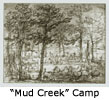 near a run known by the unpoetical sobroquet of “Mud Creek” …
near a run known by the unpoetical sobroquet of “Mud Creek” …
About 18 miles from Logansport Muddy Creek crosses
the Michigan road. Creek is called by the sobroquet which it so well
deserves – the water as it passes sluggish along has no small quantity of
alluvial matter incorporated with it. On a small prarie near this
creek on [9] Sept [1838] a thousand Indians of the Pottawattamie tribe encamped
after a hard days travel in sickness – and in tribulation. …
The group of the captive Chiefs was truly a saddening
sight, as they lay surrounded by a vigilant citizen soldiery. Nor did
their condition fail to reach even the hearts of many a settler, who
rejoiced mostly, at the 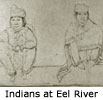 departure
of them as a nation. …
departure
of them as a nation. …
On the 9th of [Sept.], the emigration moved some 18
miles towards Logansport, and camped near Horney’s Mill, in a grove of friendly
timber near the vicinity of Eel river. Here they rested on the sabath.”
[GWMSS 1-15 [15], 2-32 [4])
 Sun-go-waw
Sun-go-waw
"[Sun-go-waw] was among the several Warriors, Chiefs, and Headmen
who were made prisoners at the Catholic Mission at the Twin Lakes. …
Sun-go-waw was one of Father Petit’s converts, and
of great usefulness to the Priest in his godly purposes and work in the
Pottawattamie people.
He acted in the capacity of Interpreter to the good
father, with marked usefulness and ability …
Sun-go-waw was among the principal men of those who
were carried prisoners (in waggons) at the head of the column of the emigration.
About one week after the departure of the Indians,
Sun-go-waw was released, and sent back to Logansport, with a despatch to
Genl. John Tipton, by Genl. Morgan, in command of the Indians. This
commission was a post of honor, which Sun-go-waw greatly appreciated.
I remember the day he appeared at Logansport. He enquired of me as
I stood at Capt. C. Vigus' Hotel corner, for Genl. Tipton's residence, which
was about a mile distant from the bridge, eastward, up the Wabash, which
he readily found.
Sun-go-waw faithfully performed the duty confided to
him. He received an answer from Genl. Tipton, and on the following
day he returned, alone to overtake the emigration, which he had left several
days previously. This was the last time that Sun-go-waw was seen on
the 'loved Wabash.'" (GWMSS 2-24 [1])
"It was in the month of [September] 1838, and on a sabbath day,
that the Pottawattamie emigration column rested within the shadow of a large
grove, near a clear stream of water, in close vicinity of the Eel River.
This was a halt after the second day's march to their far off destination,
West of the Mississippi.
It was here that the Rt. Rev. Brute, Bishop of Vincennes,
preached to 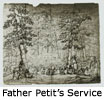 the
converted Pottawattamies ...
the
converted Pottawattamies ...
Independent
of the moral aspect of this group, it was one of beautiful picturesque effect.
The singularly draped red people, in bright and startling combinations of
color, blending in harmony with the forest rees, tinged with the influences
of the decaying year, created a deep impression upon the beholder. ...
I sketched this imposing and interesting scene, which
embraces perhaps nearly 1000 Indians. I have a Cartoon of this subject
- and it has always been a subject near my heart." (GWMSS 2-24 [1], 1-15
[13])
from Father Petit's journal of November 13, 1838:
"While I was awaiting a public stage [coach] at the hotel [in Logansport],
a traveler came up to me and presented me with a pencil sketch which seemed
to me a good one and which represented the confirmation ceremony at the camp,
the altar at the foot of the great tree, the linen tapestries, Monseigneur
[Brute], M. Mueller and me, our young interpreter, and all the Indians, with
their grave, pious solemn demeanor. I was asked several questions about
the Indians language, habits, and traditions.
|
The Emigration Continues
"The morning following this eventful and impressive day, the
emigrating column was formed, headed by the Captive Chiefs who were conveyed
in wagons, guarded by the strictest surveillance. Soon the whole nation
were seen moving down the hill sides, along the banks of the Eel river, on
the 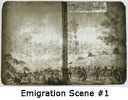 way to their westward home. ...
way to their westward home. ...
Ah! Well do I remember that scene, as the Indians
left a beautiful grove of oaks where they had encamped a few days previous
to their emigration, and descended a gentle declivity, the summit of which
commanded an extensive view of a rich and wide spreading fertile land - and
upon which with many others I stood to view with effect the little band as
they passed by us. ...
... they formed with their heavily packed ponies a
picturesque scene, which a painter could but have deemed lovely as they
followed the 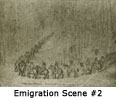 serpentine windings of a trail on the lower wild lands. ... I
gazed with many others whom curiosity had brought to the spot, at the little
emigrating band until they faded before us in the western horizon.
The Indian's is a mournful memory!
serpentine windings of a trail on the lower wild lands. ... I
gazed with many others whom curiosity had brought to the spot, at the little
emigrating band until they faded before us in the western horizon.
The Indian's is a mournful memory!
Many melancholy and touching thoughts passed through
the mind and these questions presented themselves, as the indistinct and
fast fading forms of the party were lost to the view. Has the Redman
in his entercourse with the White, witnessed the practice of the immutable
principles of justice and probity which a holy religion teaches? Has
he been taught virtue and divine reverence in 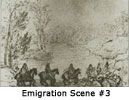 example or by precept? ... To these startling inquiries let the
page of history respond. Could the poor and degraded aborigine give
his history to the world, it could but speak in emphatic language - the
continual series of oppressions of the White man, from the day he first
put foot upon the aboriginal soil; ans surely would the gilded enblazonary
of Freedom's boasted escutcheon be tarnished in the
sight of Philanthropy and Justice." (GWMSS 1-15 [15], 2-32 [2])
example or by precept? ... To these startling inquiries let the
page of history respond. Could the poor and degraded aborigine give
his history to the world, it could but speak in emphatic language - the
continual series of oppressions of the White man, from the day he first
put foot upon the aboriginal soil; ans surely would the gilded enblazonary
of Freedom's boasted escutcheon be tarnished in the
sight of Philanthropy and Justice." (GWMSS 1-15 [15], 2-32 [2])
The Mother of We-wis-sa
"It was reported that during the emigration of the Pot-ta-wat-ta-mies
in the fall of 1838, that in consequence of the infirmities of the Mother
of We-wis-sa, she became of great inconvenience to the family in keeping
up with the main body of the Indians, and that they held a council for the
purpose of deciding whether they should dispose of the old woman by the

 tomahawk and there-by relieve themselves of the incumberence
of caring for her.
tomahawk and there-by relieve themselves of the incumberence
of caring for her.
I never heard this confirmed, and therefore never
regarded the circumstance of an authentic character worthy of indorsement."
(GWMSS 1-17 [38b])
|